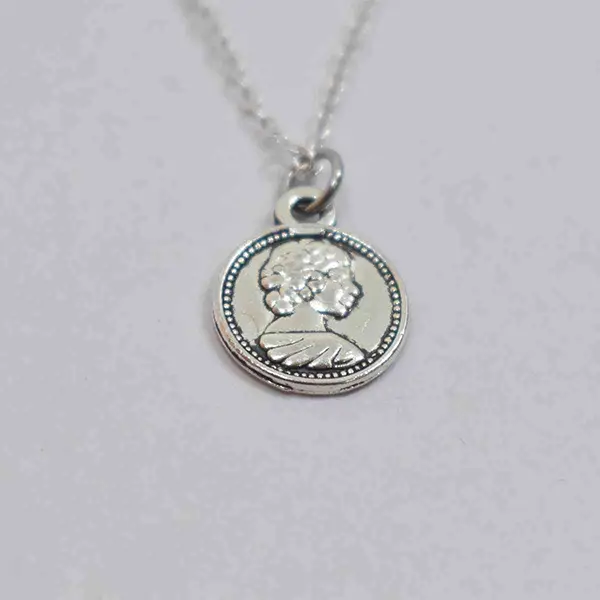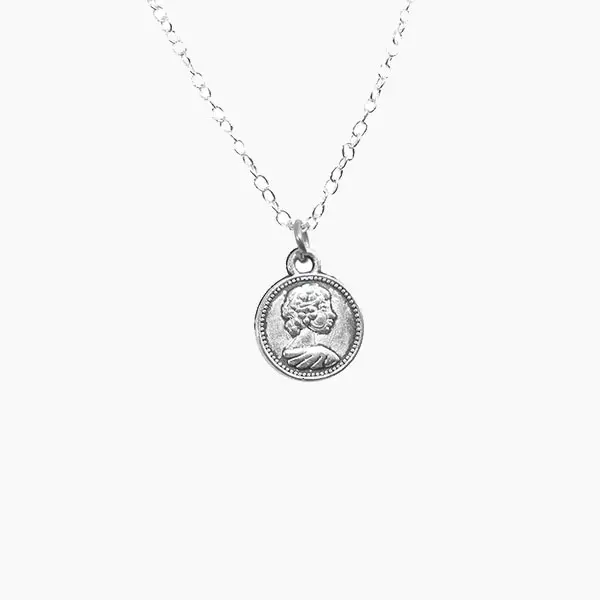Coin Face Lucky Pendant/Silver Coin Locket (सिक्का चार्म लॉकेट): The lucky charm is an object or person that is thought to bring good luck. Buy online Coin Face Lucky Charm Pendant face charm pendant to have the providential effects and as well a fashion fiesta.- Silver Coin Locket
There had been an English coin known as the sovereign, first authorized by Henry VII in 1489. It had a diameter of some 42 millimeters (1.7 in), and weighed 15.55 grams (0.549 oz), twice the weight of the existing gold coin, the ryal. The new coin(Coin Face Lucky Charm Pendant) was struck in response to a large influx of gold into Europe from West Africa in the 1480s, and Henry at first called it the double ryal, but soon changed the name to sovereign, a name he must have favored, for he also called one of his warships Sovereign of the Seas – Silver Coin Locket.
The English sovereign, the country’s first coin to be valued at one pound, was struck by the monarchs of the 16th century, the size and fineness often being altered. James I, when he came to the English throne in 1603, issued a sovereign in the year of his accession. but the following year, soon after he proclaimed himself King of Great Britain, France[a] and Ireland, he issued a proclamation for a new twenty-shilling piece. About ten percent lighter than the final sovereigns, the new coin was called the unite, symbolizing that James had merged the Scottish and English crowns – Coin Face Lucky Charm Pendant.
In the 1660s, following the Restoration of Charles II and the mechanization of the Royal Mint that quickly followed, a new twenty-shilling gold coin was issued. Silver Coin Locket had no special name at first but the public soon nicknamed it the guinea and this became the accepted term. Coins were at the time valued by their precious metal content, and the price of gold relative to silver rose soon after the guinea’s issuance. -Coin Face Lucky Charm Pendant.
Thus, it came to trade at 21 shillings or even sixpence more. Popular in commerce, the coin’s value was set by the government at 21 shillings in silver in 1717, and was subject to revision downward, though in practice this did not occur. The term sovereign, referring to a coin, fell from use—it does not appear in Samuel Johnson’s dictionary, compiled in the 1750s – Coin Face Lucky Charm Pendant.
This economy was disrupted by the Napoleonic Wars, and gold was hoarded. Among the measures taken to allow trade to continue was the issuance of one-pound banknotes. The public came to like them as more convenient than the odd-value guinea. After the war, parliament, by the Coinage Act 1816, placed Britain officially on the gold standard, with the pound to be defined as a given quantity of gold. Almost every speaker supported having a coin valued at twenty shillings, rather than continuing to use the guinea. -Coin Face Lucky Charm Pendant.
Nevertheless, the Coinage Act did not specify which coins the Mint should strike. A committee of the Privy Council recommended gold coins of ten shillings, twenty shillings, two pounds and five pounds be issued, and this was accepted by George, Prince Regent on 3 August 1816. The twenty-shilling piece was named a sovereign, with the resurrection of the old name possibly promoted by antiquarians with numismatic interests – Coin Face Lucky Charm Pendant.
William Wellesley Pole, elder brother of the Duke of Wellington, was appointed Master of the Mint (at that time a junior government position) in 1812, with a mandate to reform the Royal Mint. Pole had favored retaining the guinea, due to the number extant and the amount of labor required to replace them with sovereigns. Formal instruction to the Mint came with an indenture dated February 1817, directing the Royal Mint to strike gold coins weighing 7.988 grams, that is to say, the new sovereign – Coin Face Lucky Charm Pendant.
Italian sculptor Benedetto Pistrucci came to London early in 1816. His brilliant talent opened the doors of the capital’s elite, among them Lady Spencer, who showed Pistrucci a model of Saint George and the Dragon by Nathaniel Merchant and commissioned him to reproduce it in the Greek style as part of her husband’s regalia as a Knight of the Garter. Pistrucci had already been thinking of such a work, and he produced the cameo. The model for the saint was an Italian waiter at Brunet’s Hotel in Leicester Square, where he had stayed after coming to London – Coin Face Lucky Charm Pendant.
In 1816, Pole hired Pistrucci to create models for the new coinage. After completing Lady Spencer’s commission, by most accounts, Pistrucci suggested to Pole that an appropriate subject for the sovereign would be Saint George. He created a head, in jasper, of King George III, to be used as model for the sovereign and the smaller silver coins. He had prepared a model in wax of Saint George and the Dragon for use on the crown; this was adapted for the sovereign. The Royal Mint’s engravers were not able to successfully reproduce Pistrucci’s imagery in steel, and the sculptor undertook the engraving of the dies himself – Coin Face Lucky Charm Pendant.
Coin Face Lucky Pendant Details:
Size: 1 x 1 cm
Weight: 1 gm Approx.
Metal: Mixed
Shipping: Within 4-5 Days in India





Reviews
Clear filtersThere are no reviews yet.